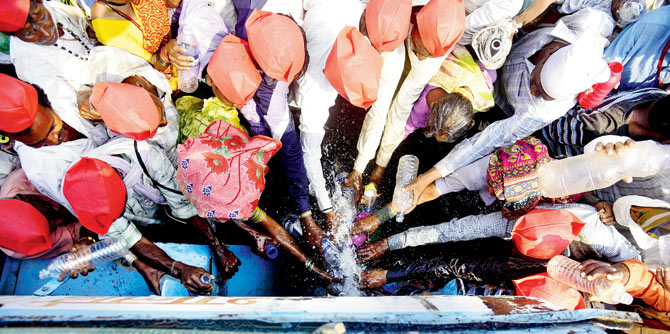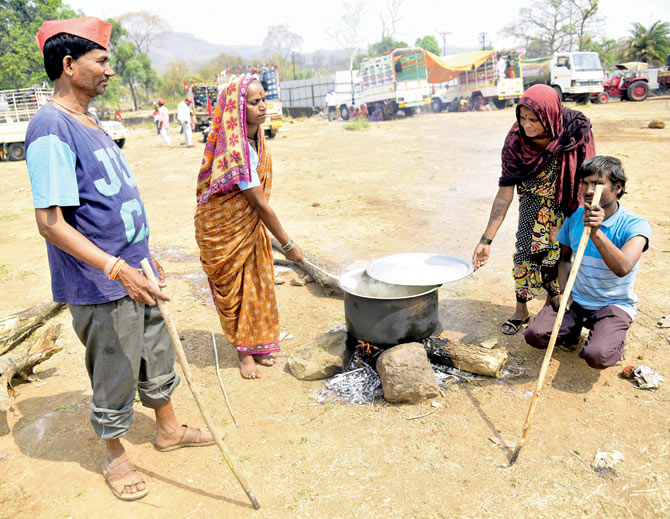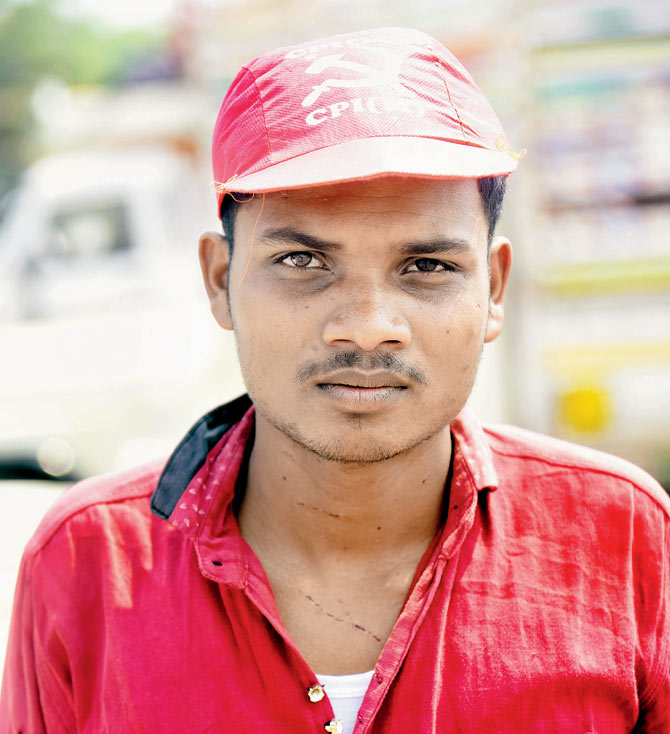Mumbai: 25,000 protesting farmers to reach Vidhan Sabha by Monday, numbers expected to grow
On a sweltering Friday afternoon, over 25,000 protesters spilled on to Mumbai-Nashik Highway near Shahapur in Thane district, bringing vehicular traffic to a grinding halt. The protesters, all members of the CPI-M’s All India Kisan Sabha (AIKS) — the country’s largest organisation representing farmers and labourers — have been covering 30 km daily, since they first set out on foot from Nashik on their 180-km-long journey to Mumbai, where they plan to gherao the Vidhan Sabha on Monday.
The farmers are demanding a slew of measures, including complete waiver of loans, fair wages for their agricultural products, compensation for crops destroyed by the pink bollworm, and immediate implementation of the Swaminathan Commission’s [see box] recommendations.
Within a span of a few days, the protest march has gathered remarkable steam with the number of protesters expected to swell to 50,000, when they arrive in Mumbai, pointing to how disillusioned the farming community currently is, in Maharashtra.

Dehydrated farmers scramble to fill their bottles in front of a water tanker, after hours of walking in the sun.
Fight to the finish
As the march reached the town of Shahapur on the fourth day of the protest, a water tanker pulled up on the side of the road to provide relief to the protesting crowd, many of whom were severely dehydrated. “Our bodies hurt, and many of us have been fainting along the way, but we won’t stop walking,” said Bansu Waghmare, 40, a farmer from Nashik’s Surana taluka, after he finished refilling his water bottle.

The farmers, who are leading the protest march, have been surviving on dal and rice, prepared by the elderly among them
While a majority of the protesters hail from Nashik, Talasari, Pune, Nagpur, Ahmednagar, farmers from the drought-afflicted Vidarbha, Marathwada, and Amravati also joined the movement.
Gorakhnath Narayan Powar, a farmer from Vani village, said that at least 250 people were participating in the march from each village. Arrangements for food were being made by the elderly, travelling in vans, mini-tempos, and cars. “We have only been eating dal and rice for the last few days. Sometimes, when we run out of dal, we eat only rice,” said Powar. “So far, the journey has not been easy. Many of us have suffered from heat strokes and the soles of our feet are sore from all the walking. But, we will not leave Mumbai till all our demands are met.”
‘BJP govt cheated us’
Sunil Malusare, the joint secretary of AIKS in the state, pointed out that the farmers of Maharashtra have been at the receiving end under both, the UPA and BJP regimes. “Both parties are two sides of the same coin, but the BJP-led government is making people fight amongst themselves, so as to distract them from the real issues,” said Malusare.
Ajit Navale, general secretary of the AIKS, Maharashtra, said that the BJP-government’s farm loan waiver, announced in June 2016, was the biggest hogwash.

The protesters, who are scheduled to arrive in Chembur on Sunday, are expected to swell to over 50,000 by tomorrow
Chief minister Devendra Fadnavis had announced a Rs 34,022 crore farm loan waiver, which was initially estimated to help 89 lakh farmers. However, the number of eligible beneficiaries got revised to 56 lakh after an online application system coupled with biometric verification using Aadhaar numbers weeded out more than 30 lakh accounts from the list of probable beneficiaries.
“The BJP did dhoka with us. Around 1,700 farmers have died in the aftermath of the announcement. They (BJP) are misleading farmers. They want to build bullet trains and give corporates discounts, but all of these profits and benefits are adversely affecting us. This is not progress,” Navale said. He added, “The focus should be on Indian farmers — to give them good prices, provide them with rationing, land, proper agricultural infrastructure and education facilities, as well as protecting them from middlemen, who only want to cut profits.”
Another problem affecting farmers is the uncertainty of income flow. “The government has also not been able to pinpoint the fixed income per farming household, but according to our surveys and analysis, the maximum amount earned by each household is not more than Rs 5,000. Even this income is not fixed,” said Navale. According to Navale, most of the farmers taking part in the protest hail from dry areas — they cultivate dry land and mostly grow rice and naachni.

Ajit Navale, general secretary of AIKS in the state
After the end of the farming season — which lasts for four months — farmers don’t have another source of income and are forced to work as labourers for meagre wages. “Because they don’t have a fixed income, farmers are unable to provide and pay for their children’s education. It’s a vicious cycle,” he said. Malusare claimed that the only way forward now is to implement the Swaminathan Commission’s recommendations, which suggests a host of measures for upliftment of the community.

Vijay Raut, 23, Surana taluka in Nashik
‘Won’t give up’
By late Friday night, the protesters had reached Bhiwandi. They are scheduled to reach Chembur today, and will gather outside the Vidhan Sabha in Nariman Point on Monday, where they will make their demands heard loud and clear. On Saturday, there were whispers in Mumbai that MNS chief Raj Thackeray had pledged his support to the AIKS’ cause, but to truly see the outcome of this farmer movement, one will have to wait till Monday. “We are least concerned about the number of days we might have to spend outside the Vidhan Sabha, but we will not compromise on the things that we are fighting for.”
Source: Mumbai: 25,000 protesting farmers to reach Vidhan Sabha by Monday, numbers expected to grow – News

